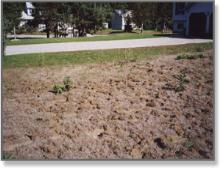Grub Control Basics
 For several years, grubs have become a major problem in our region. Commonly called “white grub”, these pests are the larvae of several beetle species – June Bugs, European Chafer beetles, and Japanese beetles. As the common name implies, these pests are white/greyish in colour with brown heads and dark hind parts.
For several years, grubs have become a major problem in our region. Commonly called “white grub”, these pests are the larvae of several beetle species – June Bugs, European Chafer beetles, and Japanese beetles. As the common name implies, these pests are white/greyish in colour with brown heads and dark hind parts.
The larvae of each beetle species are “C” shaped and are somewhat distasteful in appearance, and can be difficult to distinguish, despite the fact that the adult beetle species have different life cycles.
Adult beetles begin to lay eggs in lawns in late June through July in our region. One female beetle can lay as much as 40 eggs, with eggs usually hatching in the soil in a couple weeks. Note that eggs require water to survive, so drought conditions will cause mortality while watering your lawn may actually increase hatching and risk of damage.
In Central Ontario, larvae of June beetles and Chafer beetles were the prevalent species up until a few years ago when Japanese beetle populations started to encroach – and now cause major problems too.
Problems in lawn occur when the turf is infested with large numbers of grub that feed beneath the surface on the roots of your grass. When grub populations are high, you can grab your grass and pull it up like a carpet. This is because grub have eaten the root system so there is nothing to hold the grass plant to the soil – and nothing to feed the grass blade nutrients.
Grub Damage
 A sign that you may be in for a grub issue is the presence of large number of adult beetles in June. Since mating occurs at this time, if you see large numbers of beetles flying about at dusk, hitting windows, congregating around a light source (outside lamp post or street lights), probabilities are increased that you will have a grub problem in your lawn in the late Summer or Fall.
A sign that you may be in for a grub issue is the presence of large number of adult beetles in June. Since mating occurs at this time, if you see large numbers of beetles flying about at dusk, hitting windows, congregating around a light source (outside lamp post or street lights), probabilities are increased that you will have a grub problem in your lawn in the late Summer or Fall.
Browning of your grass, and sponginess when walking on your lawn, are also signs of grub activity. Yet the sure sign of grub activity is the presence of raccoons, skunks, and/or blackbirds digging on your lawn. These pests consider grub a delicacy and will rip and tear the turf to expose the grub and make them a delicious meal.
Grub Control and Timing
Controlling the adult beetle populations is not easy but can help in reducing egg laying, and hence reduce the number of larvae and subsequent turf damage. Adult beetle traps are effective in this regard and can be purchased at most hardware stores in our region. Traps come with a scent pouch that attracts the adult beetles. They enter the trap and are unable to exit. They will die in the trap.

Adult traps are only one way to aid in controlling grub damage. Applying beneficial nematodes – at the proper time – is the best source of control. In our area, the best, and only reasonable control time is later in the late Summer or early Fall. This is when newly hatched larvae are vulnerable to infection by the nematodes. Some stores sell nematodes in the Spring, but it is our belief this is a total waste of your time and money.
